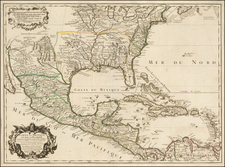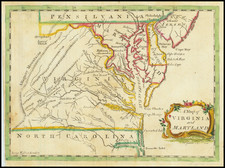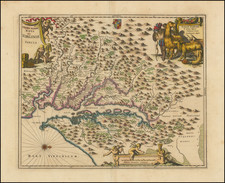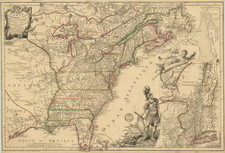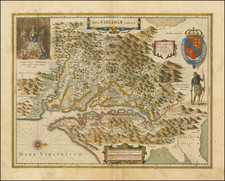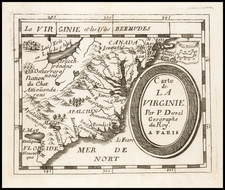Nice old color example of Faden's map showing the British attack on Fort Sullivan at the entrance to Charleston Harbor, offered here in the rare fourth and final state, with significant revisions and additions.
The British public had an insatiable appetite for battle plans and maps depicting progress of the conflict with its American colonies. The most prolific publisher was William Faden, who was granted official access to many manuscript works sent by soldiers and surveyors. These provided the most accurate details of the battles of the Revolutionary War. The present map depicts one of the most important conflicts of the War fought on Southern soil.
In early 1776, General Clinton was ordered to invade the South, where the British believed the loyal Tories would join them and reclaim the region for England. Clinton sailed from Boston where he was to meet with a British fleet under Commodore Sir Peter Parker and additional troops under Lord Cornwallis. While Clinton sailed in January 1776, it was not until the end of May that Cornwallis and Parker joined his force.
The Americans were able to prepare for Clinton's attack on Charleston, and constructed a fort at the mouth of Charleston Harbor on Sullivan's Island. Though not yet completed when Clinton's expeditionary force landed, Fort Sullivan proved effective in defending Charleston. Because the maps of the area supplied to Clinton showed an easy crossing to the mainland, Clinton's army landed on Long Island, north of Fort Sullivan. The crossing was not as easy as the map's indicated, leaving Clinton's troops unable to participate in the ensuing attack.
Parker bombarded the American fort, then under the command of Colonel William Moultrie. Despite its state of partial completion, Fort Sullivan withstood the attack and the returned cannon fire caused significant destruction to the British fleet. Parker was forced to withdraw, and Clinton's expedition ended in failure.
Faden's map shows the position of the British troops on Long Island, Fort Sullivan and Parker's fleet during the bombardment. An inset plan of the fort is included in the top left.
This is the rare 4th state of the map, which includes the following revisions from state 3:
- Second bridge of boats added to the east of the first.
- The positions of two of the ships ( Friend Ship and Thunder Bomb) have been moved to the south of group of 4 other ships firing on Fort Sulivan.
- Ranger Sloop on the east side of Long Island has been removed.
- Soundings included for the first time. Note regarding the Canal betwen the mainland and island added.
- Sand Bank and San Shoal at bottom left are new.
- "North Sand" has been replaced by "North Breaker", with the shape revised.
- A second Armed Hulk's north of Fort Sulivan has been added.
- The Deep Channel 7 Feet at the north of Sulivan's Island now includes "at low water."
The various states of the map can be identifed as follows:
- State 1: Includes dedication To Commodore Sir Peter Parker . . . in the center of the map, with two columns of text at the bottom.
- State 2: Lacking text columns, but including dedication.
- State 3: Dedication removed. A bridge of boats between the mainland and the southern tip of Sulivan's Island is added. Hetheral Point is now named and the encampment of British Soldiers is shown at Long Island.
- State 4: Second bridge of boats added to the east of the first. See other changes above.
The fourth state would seem to be the rarest of the four versions of the map, this being the first example we have seen on the market.
William Faden (1749-1836) was the most prominent London mapmaker and publisher of the late-eighteenth and early-nineteenth centuries. His father, William Mackfaden, was a printer who dropped the first part of his last name due to the Jacobite rising of 1745.
Apprenticed to an engraver in the Clothworkers' Company, he was made free of the Company in August of 1771. He entered into a partnership with the family of Thomas Jeffreys, a prolific and well-respected mapmaker who had recently died in 1771. This partnership lasted until 1776.
Also in 1776, Faden joined the Society of Civil Engineers, which later changed its name to the Smeatonian Society of Civil Engineers. The Smeatonians operated as an elite, yet practical, dining club and his membership led Faden to several engineering publications, including canal plans and plans of other new engineering projects.
Faden's star rose during the American Revolution, when he produced popular maps and atlases focused on the American colonies and the battles that raged within them. In 1783, just as the war ended, Faden inherited his father's estate, allowing him to fully control his business and expand it; in the same year he gained the title "Geographer in Ordinary to his Majesty."
Faden also commanded a large stock of British county maps, which made him attractive as a partner to the Ordnance Survey; he published the first Ordnance map in 1801, a map of Kent. The Admiralty also admired his work and acquired some of his plates which were re-issued as official naval charts.
Faden was renowned for his ingenuity as well as his business acumen. In 1796 he was awarded a gold medal by the Society of Arts. With his brother-in-law, the astronomer and painter John Russell, he created the first extant lunar globe.
After retiring in 1823 the lucrative business passed to James Wyld, a former apprentice. He died in Shepperton in 1826, leaving a large estate.









